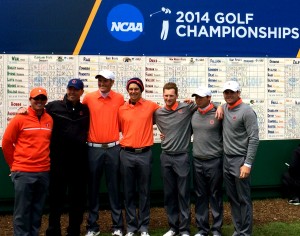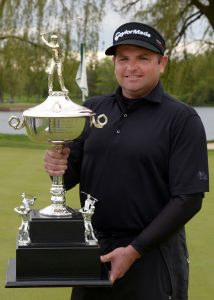Deerfield product Vince India has been struggling as a rookie on the PGA’s satellite Web.com Tour this year, but he didn’t struggle on Monday in a local qualifier for the U.S. Open.
The former University of Iowa golfer shot a 10-under-par 61 to earn medalist honors in a local qualifier at Waterlefe, in Sarasota, FL. India played there because it was close to his new residence in Lakewood Ranch, FL. India moved there after obtaining playing privileges at the Concession Club, the site of the annual Big Ten Match Play Championship.
Concession is also the home course for former PGA champion Paul Azinger and Tony Jacklin, the former U.S. and British Open champion. The name of the course was inspired by Jacklin, in honor of a memorable Ryder Cup moment when Jack Nicklaus conceded him a short putt that led to the competition between the U.S. and Europe ending in a tie in 1969. Last month Concession hosted a new team event, the Concession Cup, which pitted amateur teams from the U.S. and Europe against each other.
“This is my third winter (at Concession), and Paul Azinger’s been quite the mentor to me,’’ said India, the Illinois Amateur champion in 2010. “It’s helped for me to play at a facility that’s in major championship condition every day.’’
India didn’t survive the 36-hole cut in the rain-hampered South Georgia Classic, last week’s Web.com Tour event at Kinderlou Forest in Valdosta, Ga.. He spent time with Azinger working on his alignment after heading to Florida and it paid off in the Open qualifier.
“I’d rather have the 61 in a tournament where they pay some cash out,’’ said India. “I’ve been struggling to post a number like this on the Web.com Tour this year.’’
Still, the hot round was six strokes better than his nearest rival and put him in the sectional stage of U.S. Open qualifying. Survivors of the 36-hole sectionals advance to the U.S. Open proper at Pinehurst, N.C., next month.
Malm bids for an historic three-peat
Curtis Malm became the first player in 25 years to defend a title in the Illinois PGA Match Play Championship last year. His task will be even more historically significant when he goes for the three-peat beginning on Monday at Kemper Lakes in Long Grove.
The first of the IPGA’s four major tourneys was first held in 1952, and only two players have won three times in a row. The last was the late Bill Ogden, the long-time pro at North Shore in Glenview, who enjoyed his three-peat from 1970-72. Bob Harris, at Sunset Ridge in Northbrook, won six straight from 1958-63.
Malm is also bidding for his third straight IPGA Player-of-the-Year title. The only two who have won three straight in that category were Aurora’s Bob Ackerman (1987-89) and Steve Benson, then at Hillcrest in Long Grove (1980-82).
“A lot of neat stuff can happen this year,’’ said Malm. “This year could be fun.’’
He’s already leading the 2014 Player of the Year race after finishing third in both the season-opening Pro-Pro event and the Pekin stroke play. Next week, though, will be huge for Malm. Anticipating a first-round bye on Monday in the Match Play, he opted to enter the U.S. Open local qualifier that day at Knollwood in Lake Forest. Matches run at Kemper Lakes through Thursday.
Malm could have competed in Chicago’s other Open local, on Monday at George Dunne in Tinley Park, but preferred Knollwood after playing in the Royal Cup matches against Wisconsin’s assistant pros there last October. The George Dunne layout proved a tough test on Monday, with Garrett Chaussard, a teaching pro at Cog Hill in Lemont, the only player under par with a 1-under-71.
He led five qualifiers into next month’s sectional eliminations while Malm prepared for his big week. Though a top local player since winning the Illinois Open in 2000, Malm has yet to qualify for a U.S. Open.
A sidelight to Malm’s bid for local golf history this season also involves a job change. He was an assistant at St. Charles Country Club the last two years before taking the head job at White Eagle in Naperville during the winter.
“I’ve just been trying to get used to a new place,’’ he said, “but the members have been great. They’ve embraced my playing ability and tournament schedule.’’
Illini going to Rich Harvest
Illinois’ men couldn’t extend their Big Ten title run, finishing second to Minnesota in the league tournament at Indiana’s French Lick course on Sunday, but the Illini were awarded a good location for NCAA regional play on Monday. The Illini were assigned the No. 2 seed in the May-15-17 elimination at Rich Harvest Farms in Sugar Grove.
The top five teams at that 54-hole test will advance to the finals May 23-28 at Prairie Dunes in Kansas. Illinois (No. 8) is the only nationally-ranked team in the Big Ten. Coach Mike Small’s team finished second to Alabama in last year’s NCAA finals.
Northwestern was given the No. 10 seed in the regional at Briggs Ranch in San Antonio, Tex. Notre Dame’s Niall Platt was named one of five individual qualifiers at Rich Harvest.
Medinah event sold out
The fifth annual Medinah Patriots Day outing on May 27 is already a sellout. Tournament chairman Mark Slaby said over 200 players will participate on Medinah’s No. 2 course.
“The event’s growing, and we’re already taking reservations for next year when we go to Course One,’’ said Slaby. Medinah’s No. 1 layout is being renovated and won’t open until June.
Medinah Patriots Day is held to support families of Illinois military service men and women who lost their lives or were disabled in service to their country. Sixty-two scholarships and over 4,000 backpacks have already been provided to needy families thanks to proceeds from the event.


